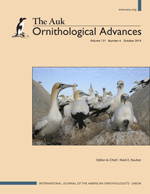Brood enlargement experiments have been conducted in several species of birds to investigate how parents of both sexes adjust their investment in the current breeding attempt. We studied parental feeding effort in the Northern Flicker (Colaptes auratus), a species with partially reversed sex roles where males invest more in parental care than females and in which there is facultative polyandry and no extra-pair young. By experimentally manipulating brood sizes to be either larger or smaller by about 40%, we tested the flexibility of provisioning responses by each sex and whether the upper limit to provisioning corresponded to the maximum clutch size in the population. Both male and female parents increased feeding rates to enlarged broods, but per-nestling provisioning declined so that they fledged lighter nestlings with shorter wings. Mortality in reduced broods was lower than in control broods, but there was no difference in the incidence of mortality between control and enlarged broods. Parents with enlarged broods raised lighter fledglings than control parents with the same brood size suggesting clutch size is individually optimized. We conclude that, although flickers were able to raise extra offspring, brood size may be individually optimized if the smaller mass and wing length of offspring lead to lower recruitment.
How to translate text using browser tools
6 August 2014
Northern Flickers increase provisioning rates to raise more but poorer quality offspring when given experimentally enlarged broods
Annessa B Musgrove,
Karen L Wiebe
ACCESS THE FULL ARTICLE

The Auk
Vol. 131 • No. 4
October 2014
Vol. 131 • No. 4
October 2014
brood size
Colaptes auratus
life history
Northern Flicker
offspring quality
Parental care
Provisioning




